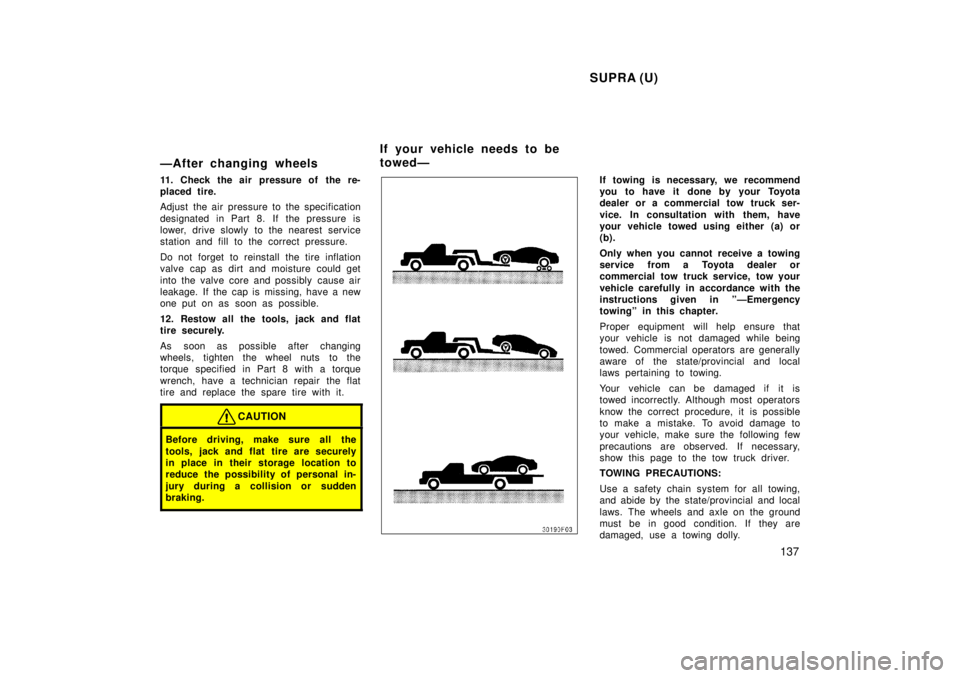Page 49 of 191

SUPRA (U)49
2. To remove the child restraint system,press the buckle- release button and al-
low the belt to retract.If your child restraint system requires
the use of a top strap, latch the hook
onto the anchor bracket and tighten the
top strap.
Twist the top strap half a turn: make a
twist at front top of the rear seatback, not
behind it. Then pass the top strap through
the cutout in the carpet on the rear cargo
floor.
See the following instructions to install the
anchor bracket.On the rear cargo floor
a. Roll back the carpet on the rear cargo
floor to find the anchor location you wish
to use.
b. Insert a 5 mm (0.5 in.) spacer and
tighten down the anchor bracket for your
child restraint system with a bolt. Torque
the bolt to 16.5Ð24.7 N Vm (1.68Ð2.52
kgf Vm, 12.2Ð18.2 ft Vlb.).
To make a cutout for the top strap pas-
sage, push open the carpet along the per-
foration with finger pressure. (The perfora-
tion can easily be seen from the back
side of the carpet.)
ÐTop strap anchors and
locations
Page 137 of 191

SUPRA (U)137
ÐAfter changing wheels
11. Check the air pressure of the re-
placed tire.
Adjust the air pressure to the specification
designated in Part 8. If the pressure is
lower, drive slowly to the nearest service
station and fill to the correct pressure.
Do not forget to reinstall the tire inflation
valve cap as dirt and moisture could get
into the valve core and possibly cause air
leakage. If the cap is missing, have a new
one put on as soon as possible.
12. Restow all the tools, jack and flat
tire securely.
As soon as possible after changing
wheels, tighten the wheel nuts to the
torque specified in Part 8 with a torque
wrench, have a technician repair the flat
tire and replace the spare tire with it.
CAUTION
Before driving, make sure all the
tools, jack and flat tire are securely
in place in their storage location to
reduce the possibility of personal in-
jury during a collision or s
udden
braking.
If towing is necessary, we recommend
you to have it done by your Toyota
dealer or a commercial tow truck ser-
vice. In consultation with them, have
your vehicle towed using either (a) or
(b).
Only when you cannot receive a towing
service from a Toyota dealer or
commercial tow truck service, tow your
vehicle carefully in accordance with the
instructions given in ºÐEmergency
towingº in this chapter.
Proper equipment will help ensure that
your vehicle is not damaged while being
towed. Commercial operators are generally
aware of the state/provincial and local
laws pertaining to towing.
Your vehicle can be damaged if it is
towed incorrectly. Although most operators
know the correct procedure, it is possible
to make a mistake. To avoid damage to
your vehicle, make sure the following few
precautions are observed. If necessary,
show this page to the tow truck driver.
TOWING PRECAUTIONS:
Use a safety chain system for all towing,
and abide by the state/provincial and local
laws. The wheels and axle on the ground
must be in good condition. If they are
damaged, use a towing dolly.
If your vehicle needs to be
towedÐ
Page 187 of 191
SUPRA (U)
188
Pedal freeplay, mm (in.):
1Ð6 (0.04±0.24)
Pad wear limit, mm (in.):
1.0 (0.04)
Lining wear limit, mm (in.):
1.0 (0.04)
Parking brake adjustment when pulled with
the foce of 196 N (20 kgf, 44 lbf):
5Ð8 clicks
Fluid type:
SAE J1703 or FMVSS No.116 DOT 3
STEERING
Wheel freeplay:
Less than 30 mm (1.2 in.)
Power steering fluid type:
Automatic transmission fluid DEXRON
�II
or III Tires
Tire size:
Spare tire
T145/70 R 17 Except spare tire
2JZ- GE engine
225/50R 16 92V (for front use only)
245/45R 16 94V (for rear use only)
2JZ- GTE engine
235/45ZR 17 (for front use only)
255/40ZR 17 (for rear use only)
Tire pressure, kPa (kgf/cm 2
or bar, psi):
Spare tire 420 (4.2, 60)
Except spare tire 230 (2.3, 33)
Wheel size: 225/50R 16 92V 16 y 8JJ
245/45R 16 94V 16 y 9JJ
235/45ZR 17 17 y 8JJ
255/40ZR 17 17 y 9.5JJ
T145/70R 17 17 y 4T
Wheel nut torque, N´m (kgf´m, ft´lbf): 103 (10.5, 76) Fuses
80050F09